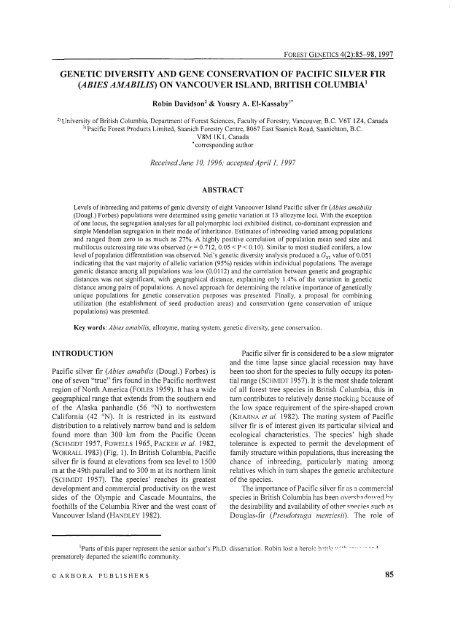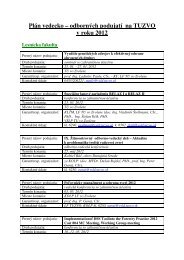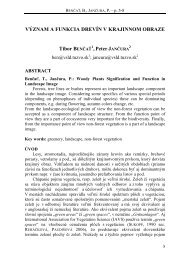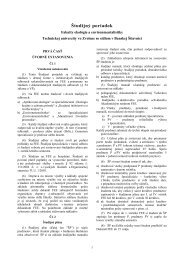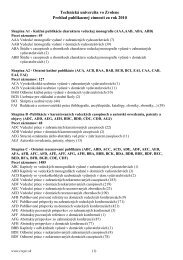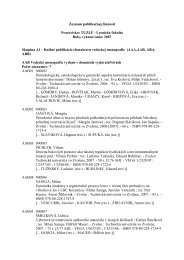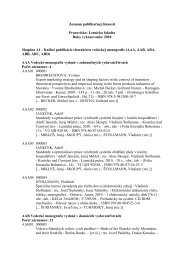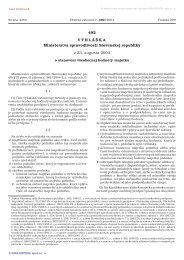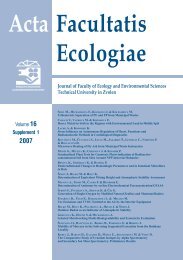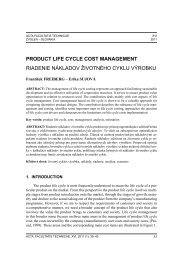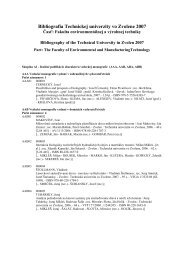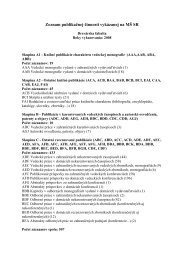(abies amabilis) on vancouver island, british columbia
(abies amabilis) on vancouver island, british columbia
(abies amabilis) on vancouver island, british columbia
You also want an ePaper? Increase the reach of your titles
YUMPU automatically turns print PDFs into web optimized ePapers that Google loves.
GENETIC DIVERSITY AND GENE CONSERVATION OF PACIFIC SILVER FIR<br />
(ABIES AMABILIS) ON VANCOUVER ISLAND, BRITISH COLUMBIA'<br />
Robin Davids<strong>on</strong>2 & Yousry A. El-Kassaby3*<br />
2)University of British Columbia, Department of Forest Sciences, Faculty of Forestry, Vancouver, B.C. V6T 124, Canada<br />
''Pacific Forest Products Limited, Saanich Forestry Centre, 8067 East Saanich Road, Saanicht<strong>on</strong>, B.C.<br />
V8M 1K1, Canada<br />
'corresp<strong>on</strong>ding author<br />
Received June 10, 1996; accepted April 1, 1997<br />
ABSTRACT<br />
Levels of inbreeding and patterns of genic diversity of eight Vancouver Island Pacific silver fir (Abies <str<strong>on</strong>g>amabilis</str<strong>on</strong>g><br />
(Dougl.) Forbes) populati<strong>on</strong>s were determined using genetic variati<strong>on</strong> at 13 allozyme loci. With the excepti<strong>on</strong><br />
of <strong>on</strong>e locus, the segregati<strong>on</strong> analyses for all polymorphic loci exhibited distinct, co-dominant expressi<strong>on</strong> and<br />
simple Mendelian segregati<strong>on</strong> in their mode of inheritance. Estimates of inbreeding varied am<strong>on</strong>g populati<strong>on</strong>s<br />
and ranged from zero to as much as 27%. A highly positive correlati<strong>on</strong> of populati<strong>on</strong> mean seed size and<br />
multilocus outcrossing rate was observed (r = 0.712, 0.05 < P < 0.10). Similar to most studied c<strong>on</strong>ifers, a low<br />
level of populati<strong>on</strong> differentiati<strong>on</strong> was observed. Nei's genetic diversity analysis produced a G,, value of 0.051<br />
indicating that the vast majority of allelic variati<strong>on</strong> (95%) resides within individual populati<strong>on</strong>s. The average<br />
genetic distance am<strong>on</strong>g all populati<strong>on</strong>s was low (0.01 12) and the correlati<strong>on</strong> between genetic and geographic<br />
distances was not significant, with geographical distance, explaining <strong>on</strong>ly 1.4% of the variati<strong>on</strong> in genetic<br />
distance am<strong>on</strong>g pairs of populati<strong>on</strong>s. A novel approach for determining the relative importance of genetically<br />
unique populati<strong>on</strong>s for genetic c<strong>on</strong>servati<strong>on</strong> purposes was presented. Finally, a proposal for combining<br />
utilizati<strong>on</strong> (the establishment of seed producti<strong>on</strong> areas) and c<strong>on</strong>servati<strong>on</strong> (gene c<strong>on</strong>servati<strong>on</strong> of unique<br />
populati<strong>on</strong>s) was presented.<br />
Key words: Abies <str<strong>on</strong>g>amabilis</str<strong>on</strong>g>, allozyme, mating system, genetic diversity, gene c<strong>on</strong>servati<strong>on</strong>.<br />
INTRODUCTION<br />
Pacific silver fir (Abies <str<strong>on</strong>g>amabilis</str<strong>on</strong>g> (Dougl.) Forbes) is<br />
<strong>on</strong>e of seven "true" firs found in the Pacific northwest<br />
regi<strong>on</strong> of North America (FOILES 1959). It has a wide<br />
geographical range that extends from the southern end<br />
of the Alaska panhandle (56 ON) to northwestern<br />
California (42 ON). It is restricted in its eastward<br />
distributi<strong>on</strong> to a relatively narrow band and is seldom<br />
found more than 300 km from the Pacific Ocean<br />
(SCHMIDT 1957, FOWELLS 1965, PACKEE et al. 1982,<br />
WORRALL 1983) (Fig. 1). In British Columbia, Pacific<br />
silver fir is found at elevati<strong>on</strong>s from sea level to 1500<br />
m at the 49th parallel and to 300 m at its northern limit<br />
(SCHMIDT 1957). The species' reaches its greatest<br />
development and commercial productivity <strong>on</strong> the west<br />
sides of the Olympic and Cascade Mountains, the<br />
foothills of the Columbia River and the west coast of<br />
Vancouver Island (HANDLEY 1982).<br />
Pacific silver fir is c<strong>on</strong>sidered to be a slow migrator<br />
and the time lapse since glacial recessi<strong>on</strong> may have<br />
been too short for the species to fully occupy its potential<br />
range (SCHMIDT 1957). It is the most shade tolerant<br />
of all forest tree species in British Columbia, this in<br />
turn c<strong>on</strong>tributes to relatively dense stockii~g b~cause of<br />
the low space requirement of the spire-shaped crown<br />
(KRAJINA et 01. 1982). The mating system of Pacific<br />
silver fir is of interest given its particular silvical and<br />
ecological characteristics. The species' high shade<br />
tolerance is expected to permit the development of<br />
family structure within populati<strong>on</strong>s, thus increasing the<br />
chance of inbreeding, particularly mating am<strong>on</strong>g<br />
relatives which in turn shapes the genetic architecture<br />
of the species.<br />
The importance of Pacific silver fir as 3 commercial<br />
species in British Columbia has been o v e r ~ h ~ h:~ ~ n ~ 4<br />
the desirability and availability of other sn~cies such as<br />
Douglas-fir (Pseudotszlga menziesii). The role of<br />
'parts of this paper represent the senior author's Ph.D. dissertati<strong>on</strong>. Robin lost a heroic b-.tt!. ,. '"- --.- --,. -- -'<br />
prematurely departed the scientific community.<br />
o ARBORA PUBLISHERS 85
R. DAVIDSON & Y. A. EL-K~ss~Y: GENE DIVERSITY AND CONSERVATION OF ABIES AA~ABILIS<br />
Pacific silver fir in future forests of British Columbia<br />
appears promising, as indicated by the species recent<br />
sharp rise in artificial regenerati<strong>on</strong> planting stocks.<br />
Given the increased utilizati<strong>on</strong> of Pacific silver fir<br />
for reforestati<strong>on</strong> and the apparent lack of informati<strong>on</strong><br />
regarding its genetics, the generati<strong>on</strong> of some knowl-<br />
edge regarding the nature and magnitude of the species<br />
mating system and genetic structure is a prerequisite to<br />
any effective management plan. This study reports <strong>on</strong>:<br />
(1) estimates of the mating system parameters, (2) the<br />
nature and extent of genic variati<strong>on</strong>, and (3) a proposed<br />
genetic c<strong>on</strong>servati<strong>on</strong> strategy for this species Vancou-<br />
ver Island populati<strong>on</strong>s. Although we realize that the<br />
populati<strong>on</strong>s studied represent <strong>on</strong>ly a small part of the<br />
species natural range, the study should be c<strong>on</strong>sidered as<br />
exploratory, preliminary informati<strong>on</strong> <strong>on</strong> the species<br />
genetics.<br />
MATERIAL AND METHODS<br />
Material<br />
C<strong>on</strong>es were collected from eight populati<strong>on</strong>s of Pacific<br />
silver fu <strong>on</strong> Vancouver Island, British Colombia (Table<br />
1, Fig. 1). Within each populati<strong>on</strong>, c<strong>on</strong>e samples were<br />
collected from individual trees using a c<strong>on</strong>e rake<br />
suspended from a helicopter (five populati<strong>on</strong>s) or were<br />
collected from the ground after tree felling (three<br />
populati<strong>on</strong>s) (Table 1). C<strong>on</strong>es were collected from<br />
individual trees and the parent-tree identity of c<strong>on</strong>es<br />
and seeds was maintained throughout the study. Given<br />
the fact that Pacific silver fir was present in these<br />
populati<strong>on</strong>s as a co-dominant species with western<br />
hemlock (Tsuga heterophylla), and that the nature of<br />
individual tree c<strong>on</strong>e collecti<strong>on</strong> was by helicopter or by<br />
hand, it is likely that sufficient distance (i.e., no co-<br />
ancestry between sampled trees) was obtained. The<br />
c<strong>on</strong>e collecti<strong>on</strong>s were made over a four week period<br />
following c<strong>on</strong>elseed ripeness checks by field pers<strong>on</strong>nel.<br />
C<strong>on</strong>es were kept in mesh bags at 4 OC until all collec-<br />
ti<strong>on</strong>s were made, then air-dried at 12-20 "C for two<br />
weeks. Seeds were extracted in a commercial c<strong>on</strong>eprocessing<br />
facility following standard methods used for<br />
the species. Seeds were hand-dewinged and filled seed<br />
samples were obtained using a vacuum separati<strong>on</strong><br />
apparatus (EDWARDS 1979). Filled seeds were x-rayed<br />
for verificati<strong>on</strong> and the percentage of filled seeds<br />
determined and seed size was indirectly estimated using<br />
1000-seed weight measures based <strong>on</strong> samples of filled<br />
seeds from individual trees.<br />
Electrophoretic methods<br />
Maternal trees' genotype for 13 allozyme loci was<br />
deduced from the allozyme phenotpeslgenotypes of 20<br />
megagametophytic tissues (In) per tree. Additi<strong>on</strong>ally,<br />
the corresp<strong>on</strong>ding embryo genotype of these 20 seeds<br />
was also determined. The probability of incorrectly<br />
classifying a heterozygote at any <strong>on</strong>e locus is (0.5)k-'<br />
where k = number of seeds (TIGERSTEDT 1973), and<br />
thus for a sample of this size, very close to zero.<br />
Electrophoresis methods and extracti<strong>on</strong> buffer are<br />
listed in EL-KASSABY et al. (1982) and CONKLE et al.<br />
(1982). Megagametophytic and embry<strong>on</strong>ic tissues were<br />
electrophoresed <strong>on</strong> 12.5% wlv horiz<strong>on</strong>tal starch-gels<br />
using two buffer systems: tris-citrate pH 7.0 and<br />
sodium borate pH 8.0. The enzyme systems studied<br />
were aspartate aminotransferase (AAT) (2.6.1.1) and<br />
malate dehydrogenase (MDH) (1.1.1.37) each with<br />
three loci, glucose-6-phosphate dehydrogenase (G6P)<br />
(1.1.1.49), glutamate dehydrogenase (GDH) (1.4.1.3),<br />
isocitrate dehydrogenase (IDH) (1.1.1.42), 6-phosphogluc<strong>on</strong>ate<br />
dehydrogenase (6PG) (1.1.1.44), phosphoglucose<br />
isomerase (PGI) (5.3.1.9), phosphoglucomutase<br />
(PGM) (2.7.5.1), and superoxide dismutase<br />
(SOD) (1.15.1.1) all with <strong>on</strong>e locus. Six out of the 13<br />
loci were polymorphic (Idh, Mdh-1, and Aat-2 with<br />
two alleles, Pgi-2 with three alleles, and G6p and Pgm<br />
with five alleles).<br />
Table 1. Sources of populati<strong>on</strong>s of Pacific silver fir c<strong>on</strong>es (populati<strong>on</strong>s are listed by latitude).<br />
Collecti<strong>on</strong> site Code Latitutde L<strong>on</strong>gitude Average elevati<strong>on</strong> (m) # of trees sampled<br />
Fleet River<br />
Mystery Creek<br />
Taylor River<br />
Sebalhall Creek'<br />
Maquilla Creek'<br />
Hathaway Creek'<br />
R<strong>on</strong>ning Creek'<br />
Holberg Inlet'<br />
Helicopter collecti<strong>on</strong>
POPULATIONS SAMPLED<br />
Q -PACIFIC SILVER FIR<br />
Figure 1. Distributi<strong>on</strong> of the Pacific silver fir in western North America showing the locati<strong>on</strong> of the eight populati<strong>on</strong>s sampled<br />
<strong>on</strong> Vancouver Island (source: DAVIDSON 1990; FOWELLS 1965).<br />
Genetic analysis<br />
Single-locus (t,) and multilocus (t,) estimates of<br />
outcrossing rate were estimated using the maximum<br />
likelihood procedure of RITLAND and EL-KASSABY<br />
(1985). Populati<strong>on</strong>s' allozyme variati<strong>on</strong> was analyzed<br />
using BIOSYS-1 (SWOFFORD & SELANDER 198 1) and<br />
GENESTAT (LEWIS & WHITKUS 1989) with the following<br />
values computed: allele frequencies and average<br />
number of alleles per locus. Average number of alleles<br />
per locus is c<strong>on</strong>sidered to reflect allelic richness, but as<br />
indicated by MARSHALL and BROWN (1975) inflates the<br />
c<strong>on</strong>tributi<strong>on</strong> low-frequency alleles make to variati<strong>on</strong>.<br />
Hence, a more informative measure is that of Crow and<br />
KIMURA (1970) known as the "effective" number of<br />
alleles per locus (n ,). Ne is greatest when alleles are of<br />
equal frequency and is close to <strong>on</strong>e if <strong>on</strong>ly <strong>on</strong>e allele is<br />
in very high frequency. Thus, ne reflects both presence<br />
and frequency of alleles (HEDRICK 1983). The effective<br />
number of alleles per locus and the average expected<br />
heterozygosities (He) were derived for each populati<strong>on</strong>.<br />
o A RBORA PUBLISHERS 87
R. DAVIDSON & Y. A. EL-KASSABY: GENE DIVERSITY AND CONSERVATION OF ABIES AMABILIS<br />
Figure 2. Dendrograms depicting hierarchical structure of<br />
genetic relatedness am<strong>on</strong>g the eight Pacific silver fir<br />
populati<strong>on</strong>s (ALL) and after the removal of each populati<strong>on</strong><br />
<strong>on</strong>e at a time from the original data set (for example, -A<br />
represents an analysis that c<strong>on</strong>tained all populati<strong>on</strong>s after the<br />
removal of the A populati<strong>on</strong> from the data).<br />
In additi<strong>on</strong>, NEI'S (1973) coefficient of genetic differen<br />
tiati<strong>on</strong> G,, was calculated for the natural populati<strong>on</strong>s to<br />
obtain estimates of the distributi<strong>on</strong> of genetic variati<strong>on</strong>.<br />
The genetic relati<strong>on</strong>ship am<strong>on</strong>g the eight popula-<br />
ti<strong>on</strong>s is presented in a hierarchical structure (genetic<br />
distance dendrograms) using the electrophoretic data<br />
following the method of NEI (1973) and the UPGMA<br />
algorithm (SNEATH & SOUL 1973). In this hierarchical<br />
structure, the populati<strong>on</strong>s that are most genetically<br />
similar will cluster together forming a branch (Fig. 2).<br />
The genetic uniqueness of a specific populati<strong>on</strong> (q)<br />
was determined as follows: (1) removing populati<strong>on</strong>'s<br />
x, data from the original data set (i.e., - q), (2) estimating<br />
the average genetic distance (6) , and G,,, for the<br />
new data set (i.e., the original eight populati<strong>on</strong>s' data<br />
set minus populati<strong>on</strong>'s xi data), and (3) comparing the<br />
G,, estimate obtained from the original analysis to that<br />
of the new eight data sets (i.e.,- x,,- x,, ..., - x,). Thus,<br />
the same analysis was repeated eight times. A similar<br />
approach was used by SLATKM (1985) in determining<br />
the magnitude and extent of gene flow am<strong>on</strong>g specific<br />
Hyla avborea populati<strong>on</strong>s and EL-KASSABY and<br />
YANCHUK (1995) in determining the genetic uniqueness<br />
of specific Pacific yew (Tmus bvevifolia) populati<strong>on</strong>s.<br />
RESULTS AND DISCUSSION<br />
Genetics of allozyme markers<br />
The mode of inheritance of the six polymorphic allo-<br />
zyme loci was determined using data generated from<br />
the haploid megagametophyte of each heterozygous<br />
mother tree. A x2 goodness-of-fit test was employed to<br />
verify the expected 1 : 1 segregati<strong>on</strong>. Similar allelic<br />
combinati<strong>on</strong>s were pooled mother trees prior to the<br />
segregati<strong>on</strong> analysis. With the excepti<strong>on</strong> of the Aat-2<br />
locus, the segregati<strong>on</strong> analyses for all the remaining<br />
observed pooled allelic combinati<strong>on</strong>s were not signifi-<br />
cantly different from the expected 1 : 1 ratio (Table 2),<br />
indicating that these allozymes exhibited distinct, co-<br />
dominant expressi<strong>on</strong> and simple Mendelian segregati<strong>on</strong><br />
in their mode of inheritance. The heterogeneity G test<br />
am<strong>on</strong>g trees' segregati<strong>on</strong> ratios was significant for<br />
three allelic combinati<strong>on</strong>s (G6P and PGI) (Table 2);<br />
however, close examinati<strong>on</strong> of these allelic combina-<br />
ti<strong>on</strong>s <strong>on</strong> an individual-tree basis indicated a lack of<br />
systematic bias towards any specific allele (data not<br />
given). C<strong>on</strong>versely, the Aat-2 locus did not exhibit the<br />
expected classical Mendelian inheritance pattern and<br />
homogeneity test am<strong>on</strong>g trees showed a c<strong>on</strong>sistent bias<br />
towards allele "1" (Table 2). This pattern supports the<br />
existence of some genetic mechanism that acts to<br />
increase its own frequency. Based <strong>on</strong> the above segre-<br />
gati<strong>on</strong> analyses, it was c<strong>on</strong>cluded that the at-2 locus<br />
was not suitable for the mating system estimati<strong>on</strong> (CHE-<br />
LIAK et al. 1984), but was applicable for the genetic<br />
diversity analyses (ADAMS 1983).
Table 2. Log-likelihood G test <strong>on</strong> segregati<strong>on</strong> ratios of seven polymorphic loci in Pacific silver fir seeds.<br />
Locus Genotype Observed ratio Pooled G' Heterogeneity G'<br />
Aat -2<br />
G~P<br />
Idh<br />
Mdh-1<br />
Pgi-2<br />
Pgm<br />
* significant at 5% level; ** significant at 1% level;: ns - not significant;<br />
I - Pooled G values indicate the overall deviati<strong>on</strong> from 1 : 1 ratio;<br />
- Heterogeneity G values indicate the amount of heterogeneity in the segregati<strong>on</strong> ratio am<strong>on</strong>g trees.<br />
- Allozymes were numbered starting with "I" for most comm<strong>on</strong> alleles; faster and slower alleles were given even and odd<br />
numbers. respectively<br />
Table 3. Allelic frequencies (most comm<strong>on</strong> alle1e)and their 95% c<strong>on</strong>fidence intervals for the maternal (ovule, 0) and<br />
outcrossing pollen (P) gene pools for the seven Pacific silver fir populati<strong>on</strong>s <strong>on</strong> Vancouver Island.<br />
Locus<br />
Idh 0<br />
P<br />
Gene Populati<strong>on</strong>'<br />
pool<br />
W (3413.55)' A (161159) B (161160) C (161159) H (261258) R (261258) N (221219)<br />
I see table 1 for populati<strong>on</strong> designati<strong>on</strong><br />
First and sec<strong>on</strong>d numbers represent the number of genes sampled from the maternal and pollen gene pools, respectively.<br />
Mating system<br />
The nature and extent of genetic variati<strong>on</strong> in a species<br />
is largely determined by its pattern of breeding. Its<br />
system of mating c<strong>on</strong>stitutes the link between succes-<br />
sive generati<strong>on</strong>s whereby genetic informati<strong>on</strong> is trans-<br />
ferred, organized and distributed am<strong>on</strong>g progeny<br />
(CLEGG 1980). Mating system studies have shown most<br />
c<strong>on</strong>ifers to be high, although not obligate, outcrossers<br />
(see ADAMS & BIRKES I991 for a review). Because the<br />
reproductive process of many ec<strong>on</strong>omically important<br />
c<strong>on</strong>ifers is characterized by some natural self-fertilizati<strong>on</strong><br />
and most exhibit large amounts of growth depressi<strong>on</strong><br />
as a result of inbreeding (FRANKLIN 1970, SORFN-<br />
SEN 1982), accurate estimates of levels of inbreeding<br />
become important in planning and implementing of tree<br />
improvement programs. Both envir<strong>on</strong>mental and<br />
genetic factors have been shown to influence mating<br />
systems (CLEGG 1980). Outcrossing rates have been<br />
reported to vary with stand density (Fmnis S ?II:TTCIN<br />
o A RBORA PUBLISHERS 89
R. DAVIDSON & Y. A. EL-U.SSABY: GENE DIVERSITY AND CONSERVATION OF ABIESAMABILIS<br />
Table 4 Estimates of single-locus (t,) and multilocus (t,) outcrossing rates for seven populati<strong>on</strong>s of Pacific silver fir<br />
from Vancouver Island, B.C. (95% c<strong>on</strong>fidence intervals)<br />
Locus<br />
Populati<strong>on</strong>'<br />
W A B C H R N<br />
Pgi-2 1.204 (0.152) 0.478 (0.206)* 0.446 (0,213)* 0.669 (0.234)* 0.647 (0.175)* 0.892 (0.167) 0.461 (0.154)'<br />
G6p 1.066 (0.151) 0.740 (0.174)* 0.906 (0.209) 0.913 (0.234) 0.903 (0.178) 0.947 (0.153) 0.803 (0.190)*<br />
Pgm 1.001 (0.107) 0.853 (0.206) 0.999 (0.220) 0.842 (0.289) 0.870 (0.179)<br />
Idh - 2 - 0.900 (0.5 15) - 0.999 (0.175)<br />
h4dh-1 - - - - 0.899 (0.269)<br />
0.999 (0.173) 0.555 (0.212)<br />
- -<br />
- -<br />
* significant at 5% level<br />
' see Table 1 for populati<strong>on</strong> designati<strong>on</strong><br />
m<strong>on</strong>omorphic locus<br />
single-locus minimum variance mean<br />
multilocus outcrossing rate<br />
' multilocus outcrossing rate based <strong>on</strong> the three comm<strong>on</strong><br />
loci<br />
Table 5. Pollen allele frequencies for six variable loci in eight populati<strong>on</strong>s of Pacific silver fir <strong>on</strong> Vancouver Island,<br />
B.C. (populati<strong>on</strong>s are arranged in order of increasing latitude and followed by sample size).<br />
Locus Allele<br />
' see Table 1 for populati<strong>on</strong> designati<strong>on</strong><br />
n; null allele<br />
Populati<strong>on</strong>'
1984, SHEA 1987), elevati<strong>on</strong> (PHILLIPS & BROWN 1977, outcrossed pollen pool is representative of the maternal<br />
Neale and Adams 1985) and populati<strong>on</strong> substructuring populati<strong>on</strong>, or c<strong>on</strong>versely, that the maternal trees are<br />
(RITLAND & EL-KASSABY 1985).<br />
representative of the stands in which they were col-<br />
The mating system of Pacific silver fir is of interest lected (BROWN et al. 1975, EL-KASSABY et al. 1987).<br />
given its particular silvical and ecological characteris- It is also noteworthy that the c<strong>on</strong>fidence intervals of<br />
tics. The high shade tolerance of Pacific silver fir pollen allele frequencies are smaller than that of ovule<br />
permits the development of family structure within allele frequencies. This is expected because of variati<strong>on</strong><br />
populati<strong>on</strong>s. The presence of family structure is c<strong>on</strong>du- in sample size (BROWN et al. 1975) and reinforces use<br />
cive to mating am<strong>on</strong>g relatives while the c<strong>on</strong>e-bearing of the pollen pool (with larger 'n') estimates in popula-<br />
30% of the canopy, most male c<strong>on</strong>es in the lower ti<strong>on</strong> genetic studies (see genetic diversity secti<strong>on</strong><br />
porti<strong>on</strong> of the crown) promotes cross-fertilizati<strong>on</strong> below) where the sample of maternal parents is limited<br />
(FRANKLIN & RITCHIE 1970, OWENS & MOLDER 1977). (EL-KASSABY 199 1). The penetrance of alleles across<br />
Although no c<strong>on</strong>trolled mating studies have been populati<strong>on</strong>s is also apparent from Table 3. Populati<strong>on</strong>s<br />
reported for Pacific silver fir, the species is character- R and W tend to be the most variable in allelic compoized<br />
by very low yields of filled seed (FRANKLIN 1974, siti<strong>on</strong> for the Pgi-2 locus and populati<strong>on</strong> W for G6p<br />
OWENS & MOLDER 1977).<br />
and Pgm. These two stands differ by nearly 2 degrees<br />
Single- (t,) and multilocus (t,,) populati<strong>on</strong> estimates latitude, with W being <strong>on</strong>e of the most southerly<br />
of outcrossing rate and outcrossed pollen allele fre- collecti<strong>on</strong>s and R the most northern. The remainder of<br />
quencies (p) for five polymorphic loci (Pgi-2, C6p, the populati<strong>on</strong>s possess quite similar allele frequencies.<br />
Pgm, Idh and Mdh-1) were determined. A multilocus This pattern has been described in other Abies species<br />
estimate of outcrossing was c<strong>on</strong>sidered more accurate (NEALE & ADAMS 1985, JACOBS et nl. 1984, SHEA<br />
and less sensitive to violati<strong>on</strong>s of model assumpti<strong>on</strong>s 1987).<br />
because a greater number of outcrosses may be identi- Table 3 also reveals that not all loci are variable<br />
fied with certainty (SHAW et al. 1981). Populati<strong>on</strong> F across all seven populati<strong>on</strong>s. However, allelic variati<strong>on</strong><br />
was originally included in the study but no estimates exists at least in the pollen pool, at Pgi-2, G6p and<br />
for outcrossing rates could be obtained using the model Pgm in all stands. VAQUERO et 01. (1989) note that loci<br />
of RITLAND and EL-KASSABY (1985). The procedure with relatively rare alleles create a large number of<br />
for estimating t and p is iterative and, in the case of empty genotypic classes in arrays of progeny from a<br />
populati<strong>on</strong> F, failed to produce c<strong>on</strong>vergent values. The single mother, which in turn, cause difficulties in<br />
n<strong>on</strong>c<strong>on</strong>vergence of estimates may be indicative of a estimating outcrossing rates. Precisi<strong>on</strong> of single locus<br />
failure of <strong>on</strong>e or more model assumpti<strong>on</strong>s (SCHOEN outcrossing rate estimates depend <strong>on</strong> allele and mater-<br />
1988, RITLAND, pers. comm). The mixed mating model<br />
assumes that "successive outcross events within a<br />
nal genotype frequencies. Marker loci that are virtually<br />
m<strong>on</strong>omorphic 07, > 0.970; SHAW & ALLARD 1982) add<br />
family arise from independent draws of pollen from the very little informati<strong>on</strong> <strong>on</strong> outcrossing (because so few<br />
total populati<strong>on</strong> of male plants" (SCHOEN & CLEGG heterozygotes are recovered in the progeny) and<br />
1984). Phenological andlor spatial variati<strong>on</strong> in pollen produce large variances (SHAW & ALLARD 1982,<br />
distributi<strong>on</strong> may modify the fertilizati<strong>on</strong> probabilities of RITLAND 1983). BROW et al. (1975) point out that the<br />
pollen genotypes such that pollen genotypes received variance of a given single locus t value is minimized<br />
by females are correlated to some degree. This scenario when allele frequencies are equal. Given these c<strong>on</strong>sidis<br />
most likely to occur when relatively few males are erati<strong>on</strong>s, rnultilocus outcrossing rate estimates were<br />
c<strong>on</strong>tributing to the pollen cloud (SCMOEN 1988). calculated using all variable loci in each populati<strong>on</strong> (t,,,)<br />
Populati<strong>on</strong> F was the highest elevati<strong>on</strong> sample in this and <strong>on</strong>ly the three most polymorphic loci (Pgi-2, G6p<br />
study, where high amounts of precipitati<strong>on</strong> andlor a and Pgm) which were also comm<strong>on</strong> to all populati<strong>on</strong>s<br />
short growing seas<strong>on</strong> may act to reduce the number of (t,,) (Table 4).<br />
parents c<strong>on</strong>tributing to the pollen cloud. FRANKLIN and Single locus estimates ivel-e significantly different<br />
RITCHIE (1970) observed close synchr<strong>on</strong>y in pollen from t = 1.0 for at least <strong>on</strong>e locus in five of seven<br />
dispersal and seed c<strong>on</strong>e receptivity in Pacific silver fir. populati<strong>on</strong>s (Table 4). Estimates of outcro;sing varied<br />
Differences between gene pools (maternal and from as low as 45% to 100% and the Pgi--2 locus gave<br />
outcrossing pollen) at any <strong>on</strong>e locus were determined c<strong>on</strong>sistently lower estimates than other loci (Table 4).<br />
by comparing the overlap of c<strong>on</strong>fidence intervals (P Variati<strong>on</strong> in single locus estimates of outcrossing is<br />
R. DAVIDSON & Y. A. EL-K~ss~Y: GENE DIVERSITY AND CONSERVATION OF ABIESA.C~I~BILIS<br />
different powers of detecti<strong>on</strong> of outcrossing events. noble fir (Abies procera) by SORENSEN et al. (1976)<br />
Whether the variati<strong>on</strong> is statistical or loci do not fit revealed that relative self-fertility is high in that speassumpti<strong>on</strong>s<br />
of the mating model, the greater degrees of cies. Embryo aborti<strong>on</strong> is comm<strong>on</strong> in Pacific silver fir<br />
freedom provided by multilocus estimates make them (OWENS & MOLDER 1977), but it is not known to what<br />
a less biased estimate of outcrossing (SHAW et al. extent embryos resulting from selfing are aborted. The<br />
1981). It can be seen from Table 4 that outcrossing species is known to produce large numbers of otherrates<br />
based <strong>on</strong> multilocus estimates differ from 1.0 in wise normal-appearing empty seeds (FRANKLIN 1974).<br />
all populati<strong>on</strong>s except B, R and W. SHAW and ALLARD Selfing reduced numbers of filled seed by 3 1% in noble<br />
(1982) suggest that where forms of inbreeding (i.e. fir (SORENSEN ef al. 1976). It may be expected then,<br />
mating am<strong>on</strong>g relatives) in additi<strong>on</strong> to selfing occur, that a positive relati<strong>on</strong>ship would exist between perthen<br />
t, is expected to be higher than single-locus centage of filled seed and outcrossing rate, with high<br />
estimates. The minimum variance mean of single-locus seed yields correlated with high levels of outcrossing.<br />
estimates were compared to corresp<strong>on</strong>ding multilocus In this study, simple correlati<strong>on</strong> between mean seed<br />
estimates for each populati<strong>on</strong> of Pacific silver fir. yield per populati<strong>on</strong> and t, was very weakly negative (v<br />
Multilocus estimates exceeded means of t, for all = -0.165) and not significant. The relati<strong>on</strong>ship has<br />
populati<strong>on</strong>s except for populati<strong>on</strong> C. Differences range intuitive appeal and had sample sizes permitted outfrom<br />
1% to nearly 6% but all fall within the limits of crossing rate estimates <strong>on</strong> an individual tree level then<br />
the 95% c<strong>on</strong>fidence intervals. NEALE and ADAMS<br />
(1985) found a similar range of differences in four<br />
the correlati<strong>on</strong> could have been based <strong>on</strong> individual<br />
variati<strong>on</strong> rather than populati<strong>on</strong> means. However, ELpopulati<strong>on</strong>s<br />
of balsam fir (Abies balsumea) and c<strong>on</strong>- KASSABY et ul. (1987) found the correlati<strong>on</strong> between<br />
cluded that mating other than selfing was not a factor. percent filled seed per tree and individual tree outcross-<br />
In Pacific silver fir, high shade tolerance and heavy ing rate in a western white pine (Pinus m<strong>on</strong>ticola)<br />
seed (FRANKLIN 1974) are c<strong>on</strong>ducive to the develop- populati<strong>on</strong> to be n<strong>on</strong>-significant. Seed yields are<br />
ment of family clusters and very likely render the subject to a number of envir<strong>on</strong>mental factors (climate,<br />
assumpti<strong>on</strong> that all inbreeding is due to self-fertilizati<strong>on</strong> insects, etc.) and a clear relati<strong>on</strong>ship, although theoretiinvalid.<br />
Differences between t, and t,, while not great cally plausible, may not be detectable from collecti<strong>on</strong>s<br />
in magnitude, are observed in 6 of 7 sampled popula- in natural stands. Seed size, however, is c<strong>on</strong>sidered to<br />
ti<strong>on</strong>s, which suggests that some mating am<strong>on</strong>g relatives be <strong>on</strong>e of the least plastic of plant characters (SORENmay<br />
be occurring and some assortative mating may be SEN & FRANKLIN 1977) and known to be under a high<br />
practiced even when complete outcrossing is apparent degree of genetic c<strong>on</strong>trol (KHALIL 1986, STOEHR &<br />
(populati<strong>on</strong>s B, R and W). Table 4 also gives multilo- FARMER 1986, CHAISURISRI et al. 1992). A highly<br />
cus estimates for each populati<strong>on</strong> based <strong>on</strong> the three positive correlati<strong>on</strong> of populati<strong>on</strong> mean seed size and<br />
comm<strong>on</strong>ly variable loci (t,,). These differences are multilocus outcrossing rate was observed in Pacific<br />
generally small and t,'s with a reduced number of loci silver fir (r = 0.712, 0.05 < P < 0.10). Seed size was<br />
are always smaller, probably as a result of reducti<strong>on</strong> in represented by mean thousand-seed weight estimates.<br />
sample size. The significance of deviati<strong>on</strong> from com- This is the reverse of that found in subalpine fir (Abies<br />
plete outcrossing does not change. Estimates of out- lasio~arpa) by SHEA (1987) where higher than average<br />
crossing obtained by single- and n~ultilocus methods outcrossing rates were obtained from trees with smaller<br />
exceed 1.0 in <strong>on</strong>e of seven populati<strong>on</strong>s (W).<br />
seeds.<br />
Given that some amount of inbreeding (as indicated Although variati<strong>on</strong> in allele frequencies is not<br />
by outcrossing rates < 1.0 in five of seven populati<strong>on</strong>s) extensive over the range of Pacific silver fir sampled,<br />
is apparent, it is pertinent to ask whether 't' reflects the there is some apparent variati<strong>on</strong> in the rate of outcrossactual<br />
amount of inbreeding taking place. RITLAND ing am<strong>on</strong>g the seven populati<strong>on</strong>s of Pacific silver fir in<br />
(1983) describes 't' as the "effective" outcross rate, a this study. The mating system is known to be dynamic<br />
summary variable representing the net effect of devia- (HAMRICK 1982) and given Pacific silver fir's ecologiti<strong>on</strong><br />
from panmixis caused by correlati<strong>on</strong>s of maternal cal status as a climax species (KRAJINA el al. 1982), it<br />
and paternal genotypes, variati<strong>on</strong> in self-compatability, is not surprising that populati<strong>on</strong> estimates of inbreeding<br />
gametic selecti<strong>on</strong> and early zygotic lethality. ADAMS were variable (from zero to as much as 27 percent).<br />
and B~RKES (1991) cauti<strong>on</strong> that s (=I- t) represents the Differences in the magnitudes of outcrossing obtained<br />
proporti<strong>on</strong> of viable progeny due to selfing, but is not by single- and multilocus estimati<strong>on</strong> procedures suggest<br />
a measure of the actual frequency of self-pollinati<strong>on</strong>, that some related matings are occurring, a result which<br />
which may be c<strong>on</strong>siderably greater. SORENSEN (1982) is not unexpected in light of the high shade tolerance<br />
maintains that self-incompatability mechanisms appear and limited seed dispersal exhibited by this species. At<br />
to be lacking in c<strong>on</strong>ifers and crossing experiments in the sampling intensity available to this study, deviati<strong>on</strong>
from panmixs could not be associated with mating regimes. Narrow distributi<strong>on</strong> (east-west) and <strong>island</strong><br />
behavior, however, seed size was str<strong>on</strong>gly related to the inhabitance may also act to restrict gene flow and<br />
extent of apparent outcrossing in Pacific silver fir. promote differentiati<strong>on</strong> (LOVELESS & HAMRICK 1984).<br />
Adequate sample size for estimating allele frequen-<br />
Genetic diversity<br />
cies should exceed nk = 100 (BROWN & MORAN 198 1)<br />
where 'n' is the number of maternal trees in the popula-<br />
As HEDRICK (1983) describes, "our fundamental ti<strong>on</strong> and 'k' equals the number of progeny per tree.<br />
interest in determining the extent of genetic variati<strong>on</strong> is Because the number of maternal trees sampled in the<br />
to document the variati<strong>on</strong> that results in selective present study is low (eight to 17), pollen allele fredifferences<br />
am<strong>on</strong>g phenotypes". Because natural quency data were chosen to represent the eight populapopulati<strong>on</strong>s<br />
of forest trees are not likely to behave as ti<strong>on</strong>s in analyses of allelic variati<strong>on</strong> and in determining<br />
ideal, panmictic breeding units, efficient sampling the diversity and genetic distance measures of NEI<br />
strategies depend up<strong>on</strong> some estimate of the degree to (1972, 1973, 1977 and 1978). Pollen allele frequencies<br />
which populati<strong>on</strong>s are subdivided genetically (GURIES are derived by "subtracting" the maternal genotype<br />
& LEDIG 1977, GREGORIUS & ROBERDS 1986). (known with virtual certainty from a sample of 20 seeds<br />
Most c<strong>on</strong>ifers exhibit similar life histories. They per tree) from the diploid embryo genotype. Pollen<br />
are l<strong>on</strong>g-lived, often occupy heterogeneous envir<strong>on</strong>- allele frequencies have been used in several studies of<br />
ments and necessarily must possess the capacity for electrophoretic variati<strong>on</strong> in c<strong>on</strong>ifers because a larger<br />
adaptati<strong>on</strong>s which enable them to remain in subsequent porti<strong>on</strong> of the populati<strong>on</strong> gene pool is represented (FINS<br />
generati<strong>on</strong>s (REHFELDT & LESTER 1969, MULLER- &LIBBY 1982, STEINHOFF et al. 1983, MILLAR 1983, LI<br />
STARCK & GREGORIUS 1986). Genetic variati<strong>on</strong> is & ADAMS 1989, SURLES et al. 1989). Where between<br />
maintained by high levels of outcrossing and mecha- generati<strong>on</strong> comparis<strong>on</strong>s were desired, maternal tree and<br />
nisms to promote outcrossing, such as inbreeding embryo allele frequencies were utilized, acknowledging<br />
depressi<strong>on</strong> and self-incompatibility, are expected to be the dependency of these two sets of data. Statistical<br />
characteristic of outbreeding species (LOVELESS & bias introduced by small sample sizes (less than 20<br />
HAMRICK 1984, LANDE & SCHEMSKE 1985).<br />
individuals) is found to be reduced by applying a<br />
As indicated above, the biology and ecology of correcti<strong>on</strong> factor of 2Nl(2N-I) to He (NEI & ROY-<br />
Pacific silver fir are unique am<strong>on</strong>g western North CHOuDHuRY 1974). This correcti<strong>on</strong> was applied to<br />
American c<strong>on</strong>ifers. Its extremely high shade tolerance estimates of He for all maternal gene pools in this study.<br />
and late successi<strong>on</strong>al status (KRAJINA et al. 1982) Pollen allele frequency estimates for individual loci<br />
coupled with producti<strong>on</strong> of heavy seeds which are often across eight populati<strong>on</strong>s are shown in Table 5. The<br />
cached by frugivores (FRANKLIN 1974) suggest at least inclusi<strong>on</strong> of Idh and Mdh-1 as polymorphic reflect<br />
the potential for some reproductive isolati<strong>on</strong> and individual frequencies where the incidence of the most<br />
populati<strong>on</strong> substructure within the species. Further, the comm<strong>on</strong> allele was less than 0.99 but when averaged<br />
ability of Pacific silver fir to occupy a variety of sites over all individuals exceeds the 99% criteri<strong>on</strong> (HARTL<br />
(SCHMIDT 1957) suggests exposure to variable selecti<strong>on</strong> 1980). There are several geographic trends apparent in<br />
Table 6. Estimati<strong>on</strong> of heterozygosity parameters for eight populati<strong>on</strong>s of Pacific silver fir from Vancouver Island,<br />
B.C.<br />
F<br />
W<br />
A<br />
B<br />
C<br />
H<br />
R<br />
N<br />
Average<br />
' See Table 1 for populati<strong>on</strong> designati<strong>on</strong>s<br />
A - asverage number of alleles per locus; n, - effective number of alleles per locus<br />
H, - expected heterozygosity for the adult and embryo populati<strong>on</strong>s<br />
0 A RBORA PUBLISHERS<br />
H, (adult) H, (embryo)
R. DAVIDSON & Y. A. EL-GISSABY: GENE DIVERSITY AND CONSERVATION OF ABIESAMABILIS<br />
Table 7. Estimates of Nei's (1973) genetic distances (below the diag<strong>on</strong>als) and geographic distance in kilometers<br />
(above the diag<strong>on</strong>als) between pairs of populati<strong>on</strong>s of Pacific silver fir.<br />
~opulati<strong>on</strong>' F W A B C H R N<br />
F - 28 110 222 225 335 368 363<br />
W 0.01 848 - 83 195 199 308 341 336<br />
A 0.01420 0.00480 - 112 1 16 225 258 254<br />
B 0.01696 0.01283 0.01433 -<br />
9 113 147 145<br />
C 0.02133 0.01517 0.01316 0.00178 - 111 145 142<br />
H 0,01745 0.01390 0.00889 0.00504 0.00192 - 33 3 2<br />
R 0.01 173 0.00596 0.00783 0.00830 0.00843 0.00617 - 15<br />
N 0.01 165 0.01080 0.01589 0.01332 0.01681 0.01359 0.00201 -<br />
see Table 1 for populati<strong>on</strong> designati<strong>on</strong><br />
the table. A private allele, found <strong>on</strong>ly in populati<strong>on</strong> A<br />
was detected at the Pgi-2 locus, whereas all other<br />
alleles occurred in at least two populati<strong>on</strong>s. Allele '2' in<br />
G6p was detected <strong>on</strong>ly in the two southernmost populati<strong>on</strong>s<br />
(F and W). The null allele ('n') was detected at the<br />
Pgm locus in <strong>on</strong>ly two of the northernmost populati<strong>on</strong>s,<br />
N and H. Variati<strong>on</strong> at Mdh-1 was found <strong>on</strong>ly in the<br />
northern sarnples (R and H). Populati<strong>on</strong>s had either<br />
four or five varying loci and three of the of 13 loci<br />
assayed were comm<strong>on</strong>ly variable (Pgi-2, G6p and<br />
Pgm). The average actual and effective number of<br />
alleles per locus are listed in Table 6. The greatest<br />
disparity in these two measures occurs in populati<strong>on</strong> H<br />
where, although a larger number of alleles were detected<br />
(1.73 alleles per locus <strong>on</strong> average), some of these<br />
alleles occurred at relatively low frequencies, reducing<br />
the effective number to 1.10. Actual allele counts did<br />
not show any trend with geography, however effective<br />
numbers of alleles were negatively correlated (r =<br />
-0.719, P < 0.05), indicating that, in general, allelic<br />
variati<strong>on</strong> decreased with increasing latitude. Overall,<br />
populati<strong>on</strong>s possessed relatively low levels of allelic<br />
diversity with n, values showing a tendency for <strong>on</strong>e<br />
allele to dominate. No populati<strong>on</strong> was devoid of<br />
variati<strong>on</strong> and n, estimated suggest that populati<strong>on</strong> W<br />
was the most genetically diverse and populati<strong>on</strong> C the<br />
most depauperate. These populati<strong>on</strong>s also had the<br />
largest and smallest samples, respectively, however<br />
Spearman's rank correlati<strong>on</strong> (ZAR 1984) failed to show<br />
any str<strong>on</strong>g relati<strong>on</strong>ship between sample size and<br />
diversity (r = 0.241), as theoretically predicted by<br />
GREGONUS (1987). Average expected heterozygosities<br />
(He) are listed in Table 6 for maternal tree and embryo<br />
gene pools with their weighted mean values. These<br />
measures of diversity showed a similar geographic<br />
trend to n,, the correlati<strong>on</strong> with latitude being negative<br />
and just significant at a = 0.05 (r = -0.643) for the<br />
maternal gene pool and also significant for the embryos<br />
gene pool (r = 4.755). This was not unexpected since<br />
both quantities were derived from similar data struc-<br />
tures. Average H,'s differed between gene pools, and in<br />
all populati<strong>on</strong>s maternal tree heterozygosity was greater<br />
than that expected for the embryo populati<strong>on</strong>.<br />
Estimates of NEI's (1978) genetic distance between<br />
pairs of Pacific silver fir populati<strong>on</strong>s al<strong>on</strong>g with their<br />
geographic distances (measured in kilometers) are<br />
presented in Table 7. All values 6 of were very close<br />
to zero. Overall, the average genetic distance was<br />
0.01 12. The smallest value joined populati<strong>on</strong>s B and C<br />
which were also in the closest geographic proximity (9<br />
km). Another two stands (N and R) which are physi-<br />
cally near each other were also shown to be genetically<br />
very similar (D = 0.0020 I). Populati<strong>on</strong> F was distin-<br />
guishable from the rest of the stands by being the most<br />
remote genetically. This trend is evident in the graphi-<br />
cal representati<strong>on</strong> shown in Figure 2. Two other<br />
subgroups appeared in the cluster diagram but group-<br />
ings do not fit any str<strong>on</strong>g geographic trend, as two of<br />
the northernmost samples (N and R) were grouped<br />
more closely with two of the southern populati<strong>on</strong>s (A<br />
and W) than with the other northern samples the two<br />
middle latitude stands (B and C). The correlati<strong>on</strong><br />
am<strong>on</strong>g genetic and geographic distances was not signi-<br />
ficant, with geographical distance, explaining <strong>on</strong>ly<br />
1.4% of the variati<strong>on</strong> in genetic distance am<strong>on</strong>g pairs of<br />
populati<strong>on</strong>s.<br />
NEI's (1977) G,, was estimated using <strong>on</strong>ly the<br />
polymorphic loci in order to emphasize the extent of<br />
populati<strong>on</strong> differentiati<strong>on</strong> (BROWN 1979). A low level<br />
of populati<strong>on</strong> differentiati<strong>on</strong> was observed and was<br />
manifest by the average G,, value of 0.05 1, or close to<br />
5% of the total diversity detected in all the samples<br />
being attributed to genetic differences am<strong>on</strong>'g popula-<br />
ti<strong>on</strong>s of Pacific silver fir (Table 8, All). Thus, the vast<br />
majority of allelic variati<strong>on</strong> (95%) resides within<br />
individual stands.<br />
The variati<strong>on</strong> in G,, am<strong>on</strong>g related species parallels<br />
results for most other c<strong>on</strong>ifer genera (reviewed by EL-
Table 8. Estimates of genetic distance and C,, values for the eight original populati<strong>on</strong>s (ALL) and the eight different runs<br />
where populati<strong>on</strong>s were removed <strong>on</strong>e at a time from the analysis (-A indicates a run without populati<strong>on</strong> A). The G,, value<br />
of the eight populati<strong>on</strong>s is in bold and G,, values that are higher than the original C,, are in italics.<br />
Populati<strong>on</strong>s<br />
Genetic --<br />
parameter<br />
All -A -B -C -F -H -N -R -W<br />
KASSABY 199 1). NEI (1 973) stresses that G,, values are<br />
populati<strong>on</strong>-specific and n<strong>on</strong>-comparable unless breeding<br />
systems are similar. Given that variati<strong>on</strong> in mating<br />
systems am<strong>on</strong>g populati<strong>on</strong>s of Pacific silver fir was<br />
detected (see mating system secti<strong>on</strong> above) and is often<br />
encountered in other c<strong>on</strong>ifers (ADAMS & BIRKES 199 1)<br />
the c<strong>on</strong>cept of a species average G,, may be inappropriate,<br />
yet NEI (1975) reports these values himself.<br />
ROBERDS and CONKLE (1984) maintain that even<br />
though allele frequencies may not differ substantially,<br />
populati<strong>on</strong> structure may still be present. The mating<br />
system can affect populati<strong>on</strong> structure by promoting or<br />
restricting hybridizati<strong>on</strong> (RITLAND 1983). Mating<br />
systems characterized by some degree of inbreeding<br />
will exhibit reduced recombinati<strong>on</strong> and increased<br />
homozygosity which ultimately restricts gene flow and<br />
decreases the effective populati<strong>on</strong> size (RITLAND 1983,<br />
LOVELESS & HAMRICK 1984). Results of the present<br />
study suggest that some evoluti<strong>on</strong>ary forces in additi<strong>on</strong><br />
to the mating system may be acting in populati<strong>on</strong>s of<br />
Pacific silver fir.<br />
The expectati<strong>on</strong> of a high degree of populati<strong>on</strong><br />
differentiati<strong>on</strong> based <strong>on</strong> the biology of Pacific silver fir<br />
was not borne out in the analysis of electrophoretic<br />
variati<strong>on</strong>, but this result may not be that surprising<br />
c<strong>on</strong>sidering the limits to detecti<strong>on</strong> placed <strong>on</strong> it by the<br />
nature of the variables being estimated. N<strong>on</strong>etheless,<br />
there are several lines of evidence which point to some<br />
limited heterogeneity am<strong>on</strong>g populati<strong>on</strong>s. Heterozygosity<br />
appears to be reduced in northern latitudes and<br />
in embryo gene pools. Heterozygosity appears to be<br />
higher in extant populati<strong>on</strong>s, suggesting selecti<strong>on</strong> is<br />
acting to eliminate inbred seeds in nature. Greater<br />
genetic diversity, as measured by n, or He, was seen in<br />
populati<strong>on</strong>s sampled in southern Vancouver Island.<br />
Interestingly, a more southerly populati<strong>on</strong>, F, was also<br />
the most genetically differentiated, as revealed by its<br />
positi<strong>on</strong> in the genetic distance dendrogram (Fig. 2).<br />
Genetic c<strong>on</strong>servati<strong>on</strong><br />
The understanding of the mating system, genetic<br />
O A RBORA PUBLISHERS<br />
structure of a species (i.e., distributi<strong>on</strong> of genetic<br />
variati<strong>on</strong> within- and am<strong>on</strong>g-populati<strong>on</strong>s), and the<br />
search for genetically unique populati<strong>on</strong>s are important<br />
for genetic management and c<strong>on</strong>servati<strong>on</strong> programs. If<br />
the species' mating system and gene flow produce a<br />
homogeneous pattern of variati<strong>on</strong> and adaptati<strong>on</strong> across<br />
its range, then it is expected that forestry activities will<br />
result in a minimal impact <strong>on</strong> its genetic structure. On<br />
the other hand, if heterogeneous levels of genetic<br />
variati<strong>on</strong> and adaptati<strong>on</strong> are present across the landscape,<br />
then forestry practices should be c<strong>on</strong>ducted in<br />
such a way that the present level of heterogeneity is<br />
maintained. If species' genetic variati<strong>on</strong> and its distributi<strong>on</strong><br />
are c<strong>on</strong>sidered during forest management, then the<br />
goal of combining the utilizati<strong>on</strong> and c<strong>on</strong>servati<strong>on</strong> of<br />
unique populati<strong>on</strong>s can be achieved. This is a fundamental<br />
c<strong>on</strong>cept that modern forestry practices should<br />
strive to embrace.<br />
The data collected from the electrophoretic assessment<br />
of genetic variati<strong>on</strong> and its apporti<strong>on</strong>ment within<br />
and am<strong>on</strong>g the eight Pacific silver fir populati<strong>on</strong>s,<br />
indicated that <strong>on</strong>ly 5% of the total allelic variati<strong>on</strong> was<br />
attributed to differences am<strong>on</strong>g populati<strong>on</strong>s (i e., 95%<br />
of the variati<strong>on</strong> resided within-populati<strong>on</strong>s). Although<br />
this value is typical of most c<strong>on</strong>ifers investigated<br />
(HAMRICK & GODT 1989), the analysis did not equivocally<br />
identify populati<strong>on</strong>s with unique genetic attributes.<br />
Although the dendrogram of the genetic distance<br />
analysis indicated that populati<strong>on</strong> F was the most<br />
genetically differentiated (Fig. 2). It should be stated at<br />
this juncture that the mean genetic distance am<strong>on</strong>g the<br />
eight populati<strong>on</strong>s was 6 = 0.007 (Table 8).<br />
The genetic relatedness am<strong>on</strong>g the eight populati<strong>on</strong>s<br />
could be presented in a hierarchical structure<br />
(dendrogram) using the electrophoretic data following<br />
the method of NEI (1973) (coefficient of gene differentiati<strong>on</strong>,<br />
G,,) (Fig. 2; All). In this hierarchical structure,<br />
the populati<strong>on</strong>s that are genetically most similar will<br />
cluster together forming a branch (Fig. 2). Populati<strong>on</strong>s<br />
that are genetically less similar will be located <strong>on</strong><br />
separate branches (Fig. 2). The genetic uniqueness of<br />
a populati<strong>on</strong> can be determined using the sane ap-
R. DAVIDSON & Y. A. EL-K~SSABY: GENE DIVERSITY AND CONSERVATION OF ABIESAM~BILIS<br />
proach after the removal of that populati<strong>on</strong> from the to detect the observed differences in G,, and genetic<br />
data, and the same analysis is repeated and new dendrogram<br />
and average genetic distance (i) as well as<br />
coefficient of gene differentiati<strong>on</strong> (G,,) for that run are<br />
calculated. The hierarchical relati<strong>on</strong>ship am<strong>on</strong>g the<br />
remaining populati<strong>on</strong>s relative to the original denndrogram<br />
can be used as an indicati<strong>on</strong> of the genetic<br />
uniqueness of the removed populati<strong>on</strong>. This approach<br />
was used by EL-KASSABY and YANCHUK (1995) in<br />
determining the genetic uniqueness of British Colunibia's<br />
Pacific yew (Tmus bvevifolia) populati<strong>on</strong>s.<br />
The electrophoretic data from the eight populati<strong>on</strong>s<br />
were used to determine the presence or absence of<br />
genetic uniqueness am<strong>on</strong>g these populati<strong>on</strong>s. A total of<br />
eight analyses were c<strong>on</strong>ducted and their corresp<strong>on</strong>ding<br />
dendrograms, 5, and G,, values were produced (Fig.<br />
2 and Table 8). Changes in the dendrogram relative to<br />
the original (All) (i.e., the relative order am<strong>on</strong>g the<br />
remaining seven populati<strong>on</strong>s) were <strong>on</strong>ly observed in<br />
cases where the Gs, value of that specific run was<br />
higher than the original analysis (Fig. 2 and Table 8).<br />
den-drogram orders.<br />
Pacific silver fir is not under any genetic improvement<br />
program in British Columbia and our seed orchard<br />
experience have indicated that seed orchards do not<br />
represent a secure source for seed producti<strong>on</strong>. It should<br />
also be stated that all current planting programs are<br />
dependent <strong>on</strong> natural-stand seed collecti<strong>on</strong>s. The<br />
knowledge gained from the species' mating system and<br />
the genetic uniqueness of some of its populati<strong>on</strong>s could<br />
be used to guide our effort in establishing several seed<br />
producti<strong>on</strong> areas. In this case, some of the seed producti<strong>on</strong><br />
areas should be established in genetically unique<br />
populati<strong>on</strong>s. This approach will provide an opportunity<br />
to combine c<strong>on</strong>servati<strong>on</strong> and utilizati<strong>on</strong> efforts in a<br />
c<strong>on</strong>structive fashi<strong>on</strong>. Estimates of inbreeding levels<br />
will be important in determining the way these populati<strong>on</strong>s<br />
should be managed to minimize inbreeding.<br />
Furthermore, the establishment of seed producti<strong>on</strong><br />
areas in genetically unique populati<strong>on</strong>s will secure their<br />
removal from short-tenn harvesting plans.<br />
Lower Gs, values than the original estimate could <strong>on</strong>ly<br />
be produced after the removal of a populati<strong>on</strong> that is<br />
REFERENCES<br />
unique (i.e., genetically different from the remaining<br />
populati<strong>on</strong>s). SLATKIN (1985) applied the same c<strong>on</strong>cept<br />
in the determinti<strong>on</strong> of gene flow am<strong>on</strong>g Hyla arbovea<br />
ADAMS, W. T. 1983: Applicati<strong>on</strong>s of isozymes in tree breeding.<br />
In: Isozymes in Plant Genetics and Breeding, Part A.<br />
Elsevier Sci. Publishing Company. (S.D. Tanksley and<br />
populati<strong>on</strong>s. In his analyis, higher gene flow estimates T.J. Ort<strong>on</strong>, eds). pp. 381-400.<br />
were observed when isolated populati<strong>on</strong>s were re- ADAMS, W.T. & BIRKES D. S. 1991: Estimating mating<br />
moved from the data. Thus, including remote populati<strong>on</strong>s<br />
in the analysis resulted in lowering the estimate of<br />
gene flow am<strong>on</strong>g all populati<strong>on</strong>s.<br />
The observed changes could be interpreted as<br />
follows: the removal of any genetically unique populati<strong>on</strong><br />
from the data resulted in the producti<strong>on</strong> of a stable<br />
patterns in forest tree populati<strong>on</strong>s. In: Biochemical<br />
Markers in the Populati<strong>on</strong> Genetics of Forest Trees<br />
(Hattemer, H.H., S. Fineschi, F. Cannata, and M.E.<br />
Malvolti, eds.). 1991 SPB Academic Publishing bv, The<br />
Hague, The Netherlands. pp. 127-1 72.<br />
BROWN, A. H. D. 1979: Enzyme polymorphisms in plant<br />
populati<strong>on</strong>s. Theor Pop. Biol. 15: 1-42.<br />
dendrogram because its removal did not affect the BROWN, A. H. D., MATHESON, A.C. & ELDRIDGE, K.G. 1975:<br />
calculati<strong>on</strong>s of the hierarchical genetic relatedness Estimati<strong>on</strong> of the mating system of Ez4calyptus obliqua<br />
am<strong>on</strong>g the remaining populati<strong>on</strong>s (i.e., this populati<strong>on</strong><br />
is not important in "anchoring" the dendrogram).<br />
C<strong>on</strong>versely, the removal of any of the genetically<br />
similar populati<strong>on</strong> affected the remaining populati<strong>on</strong>s,<br />
thus resulting in changes in the relative order of the<br />
remaining populati<strong>on</strong>s. Following this c<strong>on</strong>cept, the<br />
L'Herit. using allozyme polymorphisms. Atlst. J. Bot.<br />
23:93 1-949.<br />
BROWN; A. H. D. & G.F. MORAN, G. F. I98 1: Isozymes and<br />
the genetic resources of forest trees. In: Proc. Symp.<br />
Isozynies of N.A. For. Trees and For. Insects (M.T.<br />
C<strong>on</strong>kle, ed.) USDA For. Serv. Gen. Tech. Rep. PSW-48.<br />
pp. 1-10.<br />
eight analyses c<strong>on</strong>ducted produced a c<strong>on</strong>sistent associa- CHAISURISRI, K., EDWARDS; D. G. W. & EL-KASSABY. Y. A.<br />
ti<strong>on</strong> between the changes in the dendrogram order and 1992: Genetic c<strong>on</strong>trol of seed size and germinati<strong>on</strong> in<br />
the G,, estimates indicating that populati<strong>on</strong>s A, C, F,<br />
H, and R all harbour some unique genetic attributes, at<br />
least for the isozyme systems c<strong>on</strong>sidered. Therefore,<br />
these populati<strong>on</strong>s should be c<strong>on</strong>sidered for c<strong>on</strong>servati<strong>on</strong><br />
purposes. It is noteworthy to menti<strong>on</strong> that the<br />
average genetic distances of the eight analyses did not<br />
differ from the original 5 = 0.007 (Table 8), indicating<br />
that when the genetic distances am<strong>on</strong>g populati<strong>on</strong>s are<br />
very small, average estimates are not sensitive enough<br />
Sitka spruce. Silvne Genet. 41:348-355.<br />
CHELIAK, w: M.. MORGAN. K.. DANCIK, B. P. STROBECK, C.<br />
& YEH: F. C. H. 1984: Segregati<strong>on</strong> of allozymes in<br />
megagametophytes of viable seed from a natural populati<strong>on</strong><br />
of jack pine, Pirzus banksiana Lamb. Theor: Appl.<br />
Genet. 69: 145-1 5 1.<br />
CLEGG. M. T. 1980: Measuring plant mating systems. BioSci.<br />
30:814-818.<br />
CONKLE, M.T., P.D. HODGKISS, L.B. NUNELLY AND S.C.<br />
HUNTER. 1982: Starch gel electrophoresis of c<strong>on</strong>ifer<br />
seeds: a laboratory manual. Gen. Tech. Rep. PSW-64.
Pac. S.W. For and Range Exp. Sta. USDA For. Serv.<br />
Berkeley, Calif. 18pp.<br />
CROW, J. F. & KIMURA, M. 1970. An Introducti<strong>on</strong> to Populati<strong>on</strong><br />
Genetics Theory. Harper and Ro\< N.Y.<br />
DAVIDSON, R. H. 1990: Patterns of variati<strong>on</strong> in Pacific silver<br />
fir (Abies <str<strong>on</strong>g>amabilis</str<strong>on</strong>g> (Dougl.) Forbes) <strong>on</strong> Vancouver<br />
Island. Ph.D. Thesis. University of British Columbia,<br />
Vancouver, B.C.<br />
EDWARDS, D. G. W. 1979: An improved air seed-sorter for<br />
laboratory use. Env. Can.. For. Serv. Rep. BC-X-188,<br />
1 ~ PP.<br />
EL-KASSABY, Y. A. 1991: Genetic variati<strong>on</strong> within and<br />
am<strong>on</strong>g c<strong>on</strong>ifer populati<strong>on</strong>s: Review and evaluati<strong>on</strong> of<br />
methods. In: Biochemical Markers in the Populati<strong>on</strong><br />
Genetics of Forest Trees (Hattemer, H.H., S. Fineschi, F.<br />
Cannata, and M.E. Malvolti, eds.). 1991 SPB Academic<br />
Publishing bv, The Hague, The Netherlands. pp. 61-76.<br />
EL-KASSABY, Y. A,, MEAGHER, M. D., PARKINSON, J. &<br />
PORTLOCK, F. T. 1987: Allozyme inheritance,<br />
heterozygosity and outcrossing rate am<strong>on</strong>g Pinus m<strong>on</strong>ficola<br />
near Ladysmith, British Columbia. Heredity 58:<br />
173-181.<br />
EL-KASSABY, Y.A., YEH , F. C. & SZIKLAI, 0. 1982: Inheritance<br />
of allozyme variants in coastal Douglas-fir<br />
(Pseudotsuga menziesii var. menziesii). Can. J. Genet.<br />
Cytol. 24:325-335.<br />
EL-KASSABY, Y.A. & YANCHUK, A. D. 1995: Genetic variati<strong>on</strong><br />
of Pacific yew in British Columbia and its c<strong>on</strong>servati<strong>on</strong><br />
(Baradat, Ph., W.T. Adams, and G. Miiller-Starck,<br />
eds.). SPB Academic Publishing bv, The Netherlands.<br />
pp. 227-235.<br />
FARRIS, M. A. & MITTON, J. B. 1984: Populati<strong>on</strong> density,<br />
outcrossing rate, and heterozygote superiority in p<strong>on</strong>derosa<br />
pine. Evoluti<strong>on</strong> 38: 1 15 1-1 154.<br />
FINS, L. & LIBBY, W. J. 1982: Populati<strong>on</strong> variati<strong>on</strong> in Sequoiadendr<strong>on</strong>:<br />
Seed and seedling studies, vegetative<br />
propagati<strong>on</strong> and isozyme variati<strong>on</strong>. Silvae Genet.<br />
31:102-110.<br />
FOLES, M. W. 1959: Silvics of grand fir. U.S. For. Serv. Gen.<br />
Tech. Rep. PNW-8.<br />
FOWELLS, M. A. 1965: Silvics of forest trees of the United<br />
States. USDA Agric. Handb. No. 271. pp. 546-556.<br />
FRANKLIN, E. C. 1970: Survey of mutant forms and inbreeding<br />
depressi<strong>on</strong> in species of the family Pinaceae. USDA<br />
For. Serv. Res. Pap. SE-61, 21pp.<br />
FRANKLIN, J. F. 1974: Abies Mill. Fir. In: Seeds of Woody<br />
Plants of the United States. (C.S. Schopmeyer, Tech.<br />
Coord.) U.S.D.A. Agric. Handb. No. 450:168-I 83.<br />
FRANKLIN, J. F. & RITCHIE, G. A. 1970: Phenology of c<strong>on</strong>e<br />
and shoot development of noble fir and some associated<br />
true firs. Forest Sci. 16:356-364.<br />
GREGORIUS, H.-R. 1987: The relati<strong>on</strong>ship between the<br />
c<strong>on</strong>cepts of genetic diversity and differentiati<strong>on</strong>. Theor.<br />
Appl. Genet. 74:397-401.<br />
GREGORIUS, 1-1. -R. & ROBERDS, J. H. 1986: Measurement of<br />
genetical differentiati<strong>on</strong> am<strong>on</strong>g subpopulati<strong>on</strong>s. Theor.<br />
Appl. Genet. 71:826-834.<br />
CURIES: R.P. & LEDIG, F. T. 1977. Analysis of populati<strong>on</strong><br />
structure from allozyme frequencies. In: Proc. 14th<br />
South. For. Tree Improv. C<strong>on</strong>f. Gainsville, Fla. June<br />
14-16, 1977. pp. 246-253.<br />
0 A RBORA PUBLISHERS<br />
HAMRICK, J. L. 1982: Plant populati<strong>on</strong> genetics and evoluti<strong>on</strong>.<br />
Amer. J. Bot. 69:1685-1693.<br />
HAMRICK, J. L. & GODT, M. J. W. 1989: Allozyme diversity in<br />
plant species. In: Differentiati<strong>on</strong> patterns in higher plants<br />
(Urbanska K. ed.). Academic Press, N.Y. pp. 53-67.<br />
HANDLEY, D. L. 1982: The British Columbia industry's<br />
interest in the true firs. In: The Biology and Management<br />
of True Fir in the Pacific Northwest. (C.D. Oliver and R.<br />
M. Kenady, eds.) USDA For. Serv. Pac. Nor. West<br />
Range and Exp. Sta. and Univ. of Wash. Seattle, WA. pp.<br />
261-262.<br />
HARTL, D. L. 1980: Principles of Populati<strong>on</strong> Genetics. Sinauer<br />
Assoc. Sunderland, Mass.<br />
HEDRICK, P. W. 1983: Genetics of Populati<strong>on</strong>s. Sci. Books<br />
Int. Portola Valley, CA.<br />
JACOBS, B. F., WERTI-I. C. R. & GUTTMAN, S. I. 1984: Genetic<br />
relati<strong>on</strong>ships in Abies (fir) of eastern United States: an<br />
electrophoretic study. Can. J. Bot. 62:609-616.<br />
JONES, D. & MATLOFF, N. 1986: Statistical hypothesis testing<br />
in biology: a c<strong>on</strong>tradicti<strong>on</strong> in terms. J. Ec<strong>on</strong>. Entornol.<br />
79: 1156-1 160.<br />
KHALIL, M. A. K. 1986: Variati<strong>on</strong> in seed quality and some<br />
juvenile characters of white spruce (Picea glnuca [Moench]<br />
Voss). Silvae Genet. 35:78-85.<br />
KRAJINA, V. J., KLINW, K. & WORRALL, J. 1982. Distributi<strong>on</strong><br />
and ecological characteristics of trees and shrubs of<br />
British Columbia. Faculty of Forestry, UBC. 13Ipp.<br />
LANDE, R. & SCHEMSKE, D. W. 1985: The evoluti<strong>on</strong> of selffertilizati<strong>on</strong><br />
and inbreeding depressi<strong>on</strong> in plants. I.<br />
Genetic models. Evoluti<strong>on</strong> 39:24-40.<br />
LEWIS, P. 0. & WHITKUS, R. 1989: GENESTAT for microcomputers.<br />
Am. Soc. Plant. Tm<strong>on</strong> Ne~usletter 2: 15-16.<br />
Lr, P. & ADAMS, W. T. 1989: Range-wide patterns of allozyme<br />
variati<strong>on</strong> in Douglas-fir (Pseudotsuga rnenziesii).<br />
Can. J. For: Res. 19:149-161.<br />
LOVELESS, M. D. & HAMRICK, J. L. 1984: Ecological determinants<br />
of genetic structure in plant populati<strong>on</strong>s. Ann. Rev.<br />
Ecol. Sys. 15:65-95.<br />
MARSHALL, D. R. & BROWN, A. H. D. 1975. Optimum sampling<br />
strategies in genetic c<strong>on</strong>servati<strong>on</strong>. In: Crop Genetic<br />
Resources for Today and Tomorrow (J.H. Frankel and<br />
J.G. Hawkes, eds.) Cambridge Univ. Press, L<strong>on</strong>d<strong>on</strong>. pp.<br />
53-80.<br />
MILLAR, C. I. 1983: A steep cline in Pintrs mzrricata. Evoltrti<strong>on</strong><br />
37:3 11-319.<br />
MULLER-STARCK, G. & GREGORIUS, H.-R. 1986: M<strong>on</strong>itoring<br />
genetic variati<strong>on</strong> in forest tree populati<strong>on</strong>s. In: 18th<br />
IUFRO World C<strong>on</strong>gress, Ljubl.jana Yugoslavia, 1986.<br />
Divisi<strong>on</strong> 2, Vol. I1 (E. D<strong>on</strong>aubauer. ed.) Sept. 7-21, pp.<br />
589-599.<br />
NEALE, D. B. & ADAMS, W. T. 1985: Allozyme and matingsystem<br />
variati<strong>on</strong> in balsam fir (Abies balsanzea) across a<br />
c<strong>on</strong>tinuous elevati<strong>on</strong>al transect. Can. J. Bot. 63:2448<br />
-2453.<br />
NEI, M. 1972: Genetic distance between populati<strong>on</strong>s. Amer<br />
Nut. 106:283-292.<br />
NEI, M. 1973: Analysis of gene diversity in subdivided<br />
populati<strong>on</strong>s. Proc. h'at. Acad. Sci. US4 70:3321-3323.<br />
NEI, M. 1975: Genetic variability in natural populati<strong>on</strong>s. In:<br />
Molecular populati<strong>on</strong> genetics and evoulti<strong>on</strong>. Morth-<br />
Holland Publ. Amsterdam: Oxford. pp. 127-174.
R. DAVIDSON & Y. A. EL-K~SSABY: GENE DIVERSITY AND CONSERVATION OF ABIESAMABILIS<br />
NEI. M. 1977: F-statistics and analysis of gene diversity in<br />
subdivided populati<strong>on</strong>s. Ann. Hum. Genet. 41:225-233.<br />
NEI, M. 1978: Estimati<strong>on</strong> of average heterozygosity and<br />
genetic distance from a small number of individuals.<br />
Genetics 89583-590.<br />
NEI, M. & ROYCHOUDKURY, A. K. 1974: Sampling variances<br />
of heterozygosity and genetic distance. Genetics 76:379<br />
-390.<br />
OWENS, J. N. & MOLDER, A. A. 1977: Sexual reproducti<strong>on</strong> of<br />
Abies <str<strong>on</strong>g>amabilis</str<strong>on</strong>g>. Can. J. Bot. 55:2653-2667.<br />
PACKEE, E. C., OLIVER, C. D. & CRAWFORD, P. D. 1982:<br />
Ecology of Pacific silver fir. In: The Biology and Management<br />
of True Fir in the Pacific Northwest. (C.D.<br />
Oliver and R.M. Kenady, eds.) USDA For. Serv. Pac.<br />
Nor. West Range and Exp. Sta. and Univ. of Wash.,<br />
Seattle, WA. pp. 19-34.<br />
PHILLIPS, M. A. &BROWN, A. H. D. 1977: Mating system and<br />
hybridity in Eucalyptus patlciflora. Atlst. J. Biol. Sci.<br />
30:337-344.<br />
REHFELDT, G. E. & LESTER, D. T. 1969: Specializati<strong>on</strong> and<br />
flexibility in genetic systems of forest trees. Silvae Genet.<br />
18:118-123.<br />
RITLAND, K. 1983: Estimati<strong>on</strong> of mating systems. In: Isozymes<br />
in Plant Genetics and Plant Breeding, Part A, (S.D.<br />
Tanksley and T.J. Ort<strong>on</strong>, eds.). Elsevier, Amsterdam. pp.<br />
289-302.<br />
RITLAND, K. & EL-KASSABY, Y. A. 1985: The nature of<br />
inbreeding in a seed orchard of Douglas-fir as shown by<br />
an efficient multilocus model. Theor: Appl. Genet.<br />
71:375-384.<br />
ROBERDS, J. H. & CONKLE, M. T. 1984: Genetic structure in<br />
loblolly pine stands: allozyme variati<strong>on</strong> in parents and<br />
progeny. For. Sci. 30:3 19-329.<br />
SCHMIDT, R. L. 1957: The silvics and plant geography of the<br />
genus Abies. In: The coastal forests of British Columbia.<br />
B.C. For. Serv. Tech. Publ. T46. 3 1 pp.<br />
SCHOEN, D. J. 1988: Mating system estimati<strong>on</strong> via the <strong>on</strong>e<br />
pollen parent model with the progeny array as the unit of<br />
observati<strong>on</strong>. Heredity 60:439-444.<br />
SCHOEN, D. J. & CLEGG, M. T. 1984: Estimati<strong>on</strong> of mating<br />
system parameters when outcrossing events are correlated.<br />
Proc. hratl. Acad. Sci. USA 81:5258-5262.<br />
SHAW, D.V. & ALLARD, R. W. 1982: Estimati<strong>on</strong> of outcrossing<br />
rates in Douglas-fir using isozyme markers. Theor<br />
Appl. Genet. 62:113-120.<br />
SHAW, D.V., KAHLER, A. L. & ALLARD, R. W. 1981: A multi-<br />
locus estimator of mating system parameters in plant<br />
populati<strong>on</strong>s. Proc. kt. Acad. Sci. U.S.A. 78: 1298-1 302.<br />
SHEA, K. L. 1987: Effects of populati<strong>on</strong> structure and c<strong>on</strong>e<br />
producti<strong>on</strong> <strong>on</strong> outcrossing rates in Engelmann spruce and<br />
subalpine fir. Evoluti<strong>on</strong> 41: 124-136.<br />
SLATKIN, M. 1985: Rare alleles as indicators of gene flow.<br />
Evoluti<strong>on</strong> 3953-65.<br />
SNEATEI, P. H. A & SOKAL, R. R. 1973: Numerical Tax<strong>on</strong>omy.<br />
W. H. Freeman, San Francisco, USA.<br />
SORENSEN, F. C. 1982: The roles of polyembry<strong>on</strong>y and<br />
embryo viability in the genetic system of c<strong>on</strong>ifers.<br />
Evoluti<strong>on</strong> 36:725-733.<br />
SORENSEN, F. C. & FRANKLIN, J. F. 1977: Influence of year of<br />
c<strong>on</strong>e collecti<strong>on</strong> <strong>on</strong> seed weight and cotyled<strong>on</strong> number in<br />
Abiesprocera. Silvae Genet. 26:41-43.<br />
SORENSEN, F. C., FRANKLIN, J. F. & WOOLLARD, R. 1976:<br />
Self- pollinati<strong>on</strong> effects <strong>on</strong> seed and scedling traits <strong>on</strong><br />
noble fir. For: Sci. 22: 155-159.<br />
STEINHOFF, R. J., JOYCE, D. G. & FINS, L. 1983: Isoyzme<br />
variati<strong>on</strong> in Pirzus nz<strong>on</strong>ticola. Can. J. For. Res. 13:1122<br />
-1131.<br />
STOEHR, M. V. & FARMER, R. E. JR. 1986: Genetic and<br />
envir<strong>on</strong>mental variance in c<strong>on</strong>e size, seed yield and<br />
germinati<strong>on</strong> properties of black spruce cl<strong>on</strong>es. Can. J.<br />
For Res. 16:1149-1151.<br />
SURLES, S. E., HAMRICK, J. L. & BONGARTEN, B. C. 1989:<br />
Allozyme variati<strong>on</strong> in black locust (Robinia pseudoacacia).<br />
Can. J. F ~ Res. K 19:471-479.<br />
SWOFFORD, D. L. & SELANDER, R. B. 1981: BIOSYS-I: A<br />
FORTRAN program for the comprehensive analysis of<br />
electrophoretic data in populati<strong>on</strong> genetics and systematics.<br />
J. Hered. 72:281-283.<br />
TIGERSTEDT, P. M. A. 1973: Studies <strong>on</strong> isozyme variati<strong>on</strong> in<br />
marginal and central populati<strong>on</strong>s of Picea <str<strong>on</strong>g>abies</str<strong>on</strong>g>. Hereditas<br />
75:47-60.<br />
VAQUERO, F., VENCES, F. J. GARCIA, P., RAMIREZ, L. &<br />
PEREZ DE LA VEGA, M. 1989: Mating system in rye:<br />
variability in relati<strong>on</strong> to the populati<strong>on</strong> and plant density.<br />
Heredity 62: 17-26.<br />
WORRALL, J. 1983: Temperature-bud burst relati<strong>on</strong>ships in<br />
<str<strong>on</strong>g>amabilis</str<strong>on</strong>g> and subalpine fir provenance tests replicated at<br />
different elevati<strong>on</strong>s. Silvae Genet. 32:203-209.<br />
ZAR, J. H. 1984: Biostatistical Analysis (2nd ed.) Prentice<br />
Hall. Englewood Cliffs, N.J.


